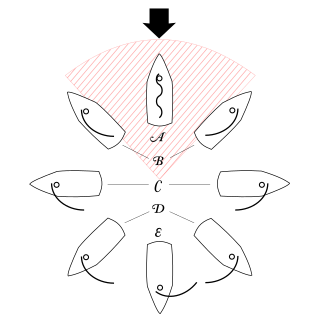Related Research Articles

A multihull is a ship or boat with more than one hull, whereas a vessel with a single hull is a monohull.

A sailboat or sailing boat is a boat propelled partly or entirely by sails and is smaller than a sailing ship. Distinctions in what constitutes a sailing boat and ship vary by region and maritime culture.

A catamaran is a multi-hulled watercraft featuring two parallel hulls of equal size. It is a geometry-stabilized craft, deriving its stability from its wide beam, rather than from a ballasted keel as with a monohull boat. Catamarans typically have less hull volume, smaller displacement, and shallower draft (draught) than monohulls of comparable length. The two hulls combined also often have a smaller hydrodynamic resistance than comparable monohulls, requiring less propulsive power from either sails or motors. The catamaran's wider stance on the water can reduce both heeling and wave-induced motion, as compared with a monohull, and can give reduced wakes.

The Tornado is a double handed multihull class recognised as an International Class by the International Sailing Federation. It was used for the Catamaran discipline at the Olympic Games from 1976 to 2008.

A point of sail is a sailing craft's direction of travel under sail in relation to the true wind direction over the surface.

A daggerboard is a retractable centreboard used by various sailing craft. While other types of centreboard may pivot to retract, a daggerboard slides in a casing. The shape of the daggerboard converts the forward motion into a windward lift, countering the leeward push of the sail. The theoretical centre of lateral resistance is on the trailing edge of the daggerboard.

A trimaran is a multihull boat that comprises a main hull and two smaller outrigger hulls which are attached to the main hull with lateral beams. Most modern trimarans are sailing yachts designed for recreation or racing; others are ferries or warships. They originated from the traditional double-outrigger hulls of the Austronesian cultures of Maritime Southeast Asia; particularly in the Philippines and Eastern Indonesia, where it remains the dominant hull design of traditional fishing boats. Double-outriggers are derived from the older catamaran and single-outrigger boat designs.
A monohull is a type of boat having only one hull, unlike multihulled boats which can have two or more individual hulls connected to one another.

Nathanael Greene Herreshoff was an American naval architect, mechanical engineer, and yacht design innovator. He produced a succession of undefeated America's Cup defenders between 1893-1920.

The Formula 16 (F16) sport catamaran is an ISAF recognised 5 m long beach catamaran with an asymmetric spinnaker setup.

A sailing hydrofoil, hydrofoil sailboat, or hydrosail is a sailboat with wing-like foils mounted under the hull. As the craft increases its speed the hydrofoils lift the hull up and out of the water, greatly reducing wetted area, resulting in decreased drag and increased speed. A sailing hydrofoil can achieve speeds exceeding twice the wind speed.
Nacra Sailing is a Dutch company that manufactures a line of small catamaran sailboats, or beachcats. NACRA was founded in 1975 to tap into the market created by Hobie Alter the founder of Hobie Cat, and several other companies offering small fiberglass catamarans designed to be sailed off the beach by a crew of one or two.
James Wharram was a British multihull pioneer and designer of catamarans.
The Viper is a performance catamaran used for racing; it is a one design within the Formula 16 class. It is recognised as a class by the International Sailing Federation.
Amaryllis is a small genus of flowering bulbs, with two species.

Trine was a 32-foot trimaran sailboat designed by Dick Newick, one the earliest designs in his career, which contributed substantially to the revival of multihull vessels from the 1960s to the late 20th century.

Victor Tchetchet (1891–1974) was a pioneering early modern multihull sailboat designer from Ukraine who is thought to have coined the term 'trimaran', though Éric de Bisschop built a trimaran in France earlier.

Tarantella was a 33 ft (10 m) sailing catamaran designed by Nathanael Greene Herreshoff. She was launched in 1877, a year after Herreshoff's smaller catamaran Amaryllis won the 1876 New York Centennial Regatta, which resulted in multihulls being banned from regattas. The Tarantella was 15 inches (38 cm) longer than her two patented sisterships Teaser and John Gilpin. She was eventually exported to the United Kingdom. The brother of her designer described these catamarans as outstanding upwind performers:
I can, with a good whole-sail breeze, beat to windward faster, by a mile an hour at least, than any other sailing vessel afloat.
T26 was a trimaran sailboat designed by Victor Tchetchet in the very late 1940s or early in 1950. It was the predecessor to his later craft Egg Nog.
The Nacra 15 is a performance catamaran used for racing. It went into production in 2015. It was designed as a smaller version of the Olympic multihull class, the Nacra 17.
References
- 1 2 3 Randy Thomas (June 1985). "Multihulls Discovered: Part 1: Their origins, myths, magic, mana... and caveats that go along with these craft that have evolved from ancient heritage". Yachting . pp. 84–87. Retrieved January 7, 2015.